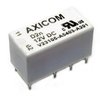Yeah, I do. It's the dreaded "Little arcs across worn-out relay contacts" problem. I don't know just exactly why the 300A in particular is so likely to do this. I have seen it over and over. The relays in this amplifier are closing only partway because of wear and tear (and age). This causes a small, blue arc to jump across this small gap between the contact points. The RF energy in this arc gets amplified by the tubes, and causes a lot of RF power to appear between the driver cathodes and ground. So what, you say? That's where the transmitter is tied in, to those driver cathodes. This creates the rare, but famous and legendary "Back-Feed" literally jumping out of the amplifier back upstream into your radio final.
It doesn't have to do this for very long. One thousandth of a second is plenty long enough for this excess RF voltage to exceed the breakdown rating of a 12-volt RF transistor like a 2SC1969 or 2SC2312. The final's base resistor and/or bias circuit can get sideswiped along with the final.
Watching the output of this 300A on a 'scope (using a tube radio to drive it) will usually show a fuzzy trace briefly at key-up, revealing a short burst of arc on one or more of the relays.
You didn't say which version 300A you have. The one with three identical relays on a plug-in circuit board behind the meter is a real pain. The R10-E3604 relay was made custom, and became unavailble when RF Parts finally ran out of them about 10 years ago. We use a more mundane relay sold by Rat Shack and others, using wire jumpers soldered to the relay lugs, and routed to the correct PC board hole. Pretty annoying. The Rat Shack DPDT 10 Amp 12 Vdc relay is rated at 10 amps, and should last a while, at least.
The later version has the relay circuit board soldered in, bolted to the deck beneath the meter. The plug-in relay R10-E1-Y2-12Vdc is pretty generic, made by lots of competitors and sold a lot of places, like Mouser. The two little square, short white or yellow plastic relays that are soldered down are expensive when you can find them. Candyman used to have a generic substitute made by "American Zettler" with a number that started "AZ-931". An outfit called "Master Distributors" had some Potter and Brumfield R50-E2-Y2-12VDC like the originals for $35.00 EACH last year. I didn't buy any at that price.
One of these is the preamp relay. You can save a little by replacing that one with a jumper wire, and kissing off the preamp. The other one of these two short relays is likeliest to be the culprit. It does two things: 1)keys the plug-in relay, and 2)turns on the tubes. When it arcs, it sends accidental BROADBAND RF drive into the tubes, and they try to oscillate. They really don't have to do this for very long to assasinate a final. The "one-key radio assasin" syndrome (OKRA ??) calls for replacing both the relays used for transmit. Good luck finding them. If it's a problem, say so. I'll check back on this thread later. I can probably find a source, if I know which relay type(s) yours has in it.
Oh, and on the Galaxy/Connex radios. Did you check the small resistor that feeds the base leg of the final? If it's bad, the bias diode and the bias trimpot are both under suspicion. If those two parts were damaged, they can kill a new final even without the 300A in line. The easiest first test of a radio with no wattmeter reading on transmit is another radio in the room on the same channel. If it can hear anything when you key, even a weak dead carrier, this narrows the troubleshooting a LOT.
Just don't be tempted to replace just one. Both the relays used for transmit should go, whichever version you have.
73



































